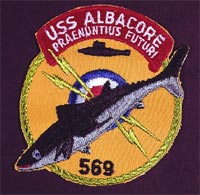
Back USS Albacore (AGSS-569) Afrikaans Albacore Park CEB USS Albacore (AGSS-569) Czech USS Albacore (AGSS-569) German USS Albacore (AGSS-569) Spanish یواساس الباکور (ایجیاساس-۵۶۹) Persian USS Albacore (AGSS-569) French アルバコア (AGSS-569) Japanese USS Albacore (AGSS-569) Polish USS Albacore (AGSS-569) Russian
 USS Albacore off the coast of Rhode Island
| |
| History | |
|---|---|
| Name | Albacore |
| Namesake | Albacore |
| Ordered | 24 November 1950 |
| Builder | Portsmouth Naval Shipyard of Kittery, Maine |
| Laid down | 15 March 1952 |
| Launched | 1 August 1953 |
| Sponsored by | Mrs. J. E. Jowers, the widow of Chief Motor Machinist's Mate Arthur L. Stanton, lost with the second Albacore (SS-218) |
| Commissioned | 6 December 1953 |
| Decommissioned | 9 December 1972 |
| Stricken | 1 May 1980 |
| Motto |
|
| Status | Donated as a museum and memorial in Portsmouth, New Hampshire |
| Badge |  |
| General characteristics - Final Phase 4 Configuration | |
| Displacement | 1606.62 tons surface[1] 1823.51 tons submerged[1] |
| Length | 205 ft 4.75 in (62.6047 m)[1] Length between perpendiculars 200 ft 0 in (60.96 m)[1] |
| Beam | 27 ft 3.75 in (8.3249 m)[1] |
| Draft | Forward 19 ft 1 in (5.82 m)[1] Aft 22 ft 3 in (6.78 m)[1] |
| Propulsion | Two 7,500 shp, counter-rotating electric motors, Two 1,000 bhp/817 kW diesel/electric generators[1] |
| Speed | |
| Range | Varied with configuration |
| Complement | 5 officers, 49 men |
| Armament | None[2] |
USS Albacore (AGSS-569) is a unique research submarine that pioneered the American version of the teardrop hull form (sometimes referred to as an "Albacore hull") of modern submarines. The revolutionary design was derived from extensive hydrodynamic and wind tunnel testing, with an emphasis on underwater speed and maneuverability.[4] She was the third vessel of the United States Navy to be named for the albacore.
Her keel was laid down on 15 March 1952 by the Portsmouth Naval Shipyard of Kittery, Maine.[5] She was launched on 1 August 1953, sponsored by Mrs. J. E. Jowers, the widow of Chief Motor Machinist's Mate Arthur L. Stanton, lost with the second Albacore (SS-218),[6][7] and commissioned on 6 December 1953 with Lieutenant Commander Kenneth C. Gummerson in command.[8][9]
The effectiveness of submarines in World War II convinced both the Soviet Navy and the United States Navy that undersea warfare would play an even more important role in coming conflicts and dictated development of superior submarines. The advent of nuclear power nourished the hope that such warships could be produced. The effort to achieve this goal involved the development of a nuclear propulsion system and the design of a streamlined submarine hull capable of optimum submerged performance.
- ^ a b c d e f g h Damage Control Book: AGSS569 (U). Washington, D.C.: Department of the Navy, Naval Ship Systems Command. 1971. pp. Section 12, 5–8.
- ^ Polmar & Moore, p.129
- ^ Tyler, Patrick (1986). Running Critical: The Silent War, Rickover and General Dynamics. New York: Harper and Row. p. 70.
- ^ Scrafford, Julie (2006). "Albacore: Forerunner to the Future". Undersea Warfare. 8 (4). U.S. Navy. Archived from the original on 22 May 2011. Retrieved 25 January 2011.
- ^ "Keel for Albacore, Experimental Sub, Laid at Shipyard". The Portsmouth Herald. Portsmouth, New Hampshire. 17 March 1952. p. 1. Retrieved 3 April 2018 – via newspapers.com.
- ^ "Albacore Launching Scheduled Today at Naval Shipyard". The Portsmouth Herald. Portsmouth, New Hampshire. 1 August 1953. p. 1. Retrieved 3 April 2018 – via newspapers.com.
- ^ "Albacore Launching Scheduled Today at Naval Shipyard (cont)". The Portsmouth Herald. Portsmouth, New Hampshire. 1 August 1953. p. 2. Retrieved 3 April 2018 – via newspapers.com.
- ^ "New Type Sub Commissioned at Portsmouth". The Boston Globe. 6 December 1953. p. C22. Retrieved 3 April 2018 – via pqarchiver.com.
- ^ "Submarine Commissioned". News-Journal. Mansfield, Ohio. 10 December 1953. p. 26. Retrieved 3 April 2018 – via newspapers.com.